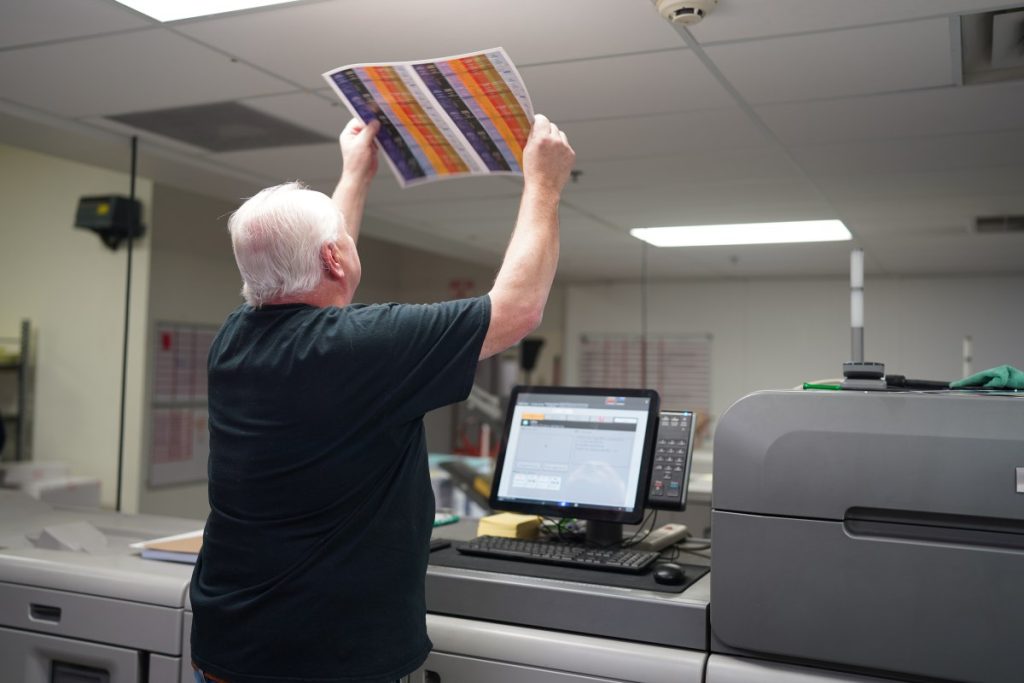

The book printing industry is constantly evolving, driven by technological advancements, shifting consumer preferences and economic factors. As we move further into 2025, several key trends are likely to shape the landscape for both publishers and consumers.
The Rise of Digital Inkjet Printing
In 2024, Printing Impressions reported digitally printed books are becoming more popular due to publishers’ desire for short print runs and quick turnarounds. Digital inkjet printing has been steadily gaining ground in recent years, and this trend is expected to continue. This technology offers several advantages, including:
- Customization options: Digital inkjet makes it easy to customize individual books without needing to create special plates. This capability has a variety of use cases in book printing, from including access codes in education books to personalization options for novels or photo books.
- On-demand printing: Digital inkjet allows for the printing of books in smaller quantities, reducing inventory costs and minimizing waste. This is particularly beneficial for niche titles and self-published works.
- Flexible order sizes: Digital inkjet printing enables a wide range of run lengths to be printed, whether publishers need one copy or thousands. This flexibility makes it easier to meet consumer demand.
As digital inkjet technology continues to improve in terms of speed, quality and affordability, it is poised to be an efficient printing method for many book publishing scenarios.
Print-on-Demand
Print-on-demand (POD) is increasingly vital, offering significant advantages for publishers and authors. Its core strength lies in enabling printing only when orders are placed, eliminating costly inventory storage. Key benefits driving its growth include:
- Scalable Production: POD efficiently handles fluctuating demand, especially for niche titles and social media-driven trends, ensuring production scales precisely with real-time orders.
- Personalization Options: POD facilitates personalized book creation, like customized educational books, catering to the rising demand for unique reading experiences.
- Integrated Workflows: POD integrates seamlessly with online sales and order management, streamlining the publishing process for self-publishers and traditional publishers alike.
Book Market Segment Trends in 2025
In 2025, we predict specific trends to continue in key book printing segments, based on what we’ve been seeing over the last few years.
Educational Books
- POD and variable data printing will drive personalized learning, enabling custom materials and rapid curriculum updates.
- Emphasis on agile delivery and reduced inventory.
Trade Books
- Data-driven inventory management will optimize print runs and minimize waste.
- Dynamic list management will allow for targeted marketing and hybrid print/digital strategies.
Self-Publishing
- Affordable POD and streamlined storefront integration will empower authors who self-publish.
- Increased access to high-quality print options and continued focus on lowering cost.
- Increase in demand for short-run digital printing.
The Impact of Foreign Import Tariffs
The imposition of tariffs on imported goods, including paper and printing materials, can have a significant impact on the book printing industry. These tariffs can lead to:
- Increased production costs: Higher costs for raw materials may translate into higher production costs for book printers.
- Price increases for consumers: To maintain profitability, publishers may be forced to increase the prices of their books, potentially impacting consumer demand.
- Shift towards domestic production: Tariffs may incentivize a shift towards domestic production of paper and other printing materials, potentially supporting local economies but also potentially leading to higher production costs in the short term.
The long-term impact of tariffs on the book printing industry will depend on a variety of factors, including the specific tariffs imposed, the availability of domestic alternatives and the overall economic climate.
Sustainability Considerations
Environmental sustainability is becoming an increasingly important consideration for consumers and businesses alike. In the book printing industry, this translates into a growing demand for:
- Sustainable printing practices: Printers are increasingly adopting eco-friendly practices, such as using recycled paper, minimizing waste and reducing energy consumption.
- Plant-based inks and coatings: The use of plant-based inks and coatings is gaining traction as a more environmentally friendly alternative to traditional petroleum-based products.
- Friendly forestry: As environmental concerns become more prevalent among consumers, forestry practices may come under more scrutiny in the coming year.
Many consumers are increasingly willing to pay a premium for products that are produced in an environmentally responsible manner, and this trend is likely to continue to influence the book printing industry.
Stay Ahead of the Curve With Walsworth
Walsworth is well-positioned to help guide its customers to the future of book printing. Our company is actively making strides to stay ahead of book printing trends and remain on the cutting edge of printing technology.
Walsworth’s Digital Inkjet Capabilities
Walsworth recently acquired Documation in Eau Claire, Wisconsin, adding state-of-the-art digital inkjet printing technology and print-on-demand to our wide list of capabilities.
Walsworth’s Commitment to Sustainability
From the forest to the press, Walsworth leads the way in sustainable printing practices. By investing in low-emission printing equipment, using vegetable-oil-based ink and prioritizing recycling at every step of the printing process, we are actively working to minimize our carbon footprint.
Additionally, Walsworth holds certifications with the Sustainable Forestry Initiative® program and the Forest Stewardship Council. That means we purchase, track, produce and deliver products with raw materials harvested and produced from responsible and renewable sources.
Walsworth’s Resistance to Foreign Import Tariffs
Many printing companies may feel harsh effects from potential foreign impact tariffs in 2025. However, thanks to our largely domestic supply chain, Walsworth stands in a strong position to resist the impacts of foreign import tariffs and pass those savings on to our customers.
Plan for the Future by Partnering With Walsworth
The book printing industry is poised to continue evolving in the coming years. By embracing technological advancements, adapting to changing consumer preferences and prioritizing sustainability, publishers and printers can navigate these changes and continue serving their customers with modern solutions. As the number 5 book printer in the U.S. and Canada, Walsworth is proud to serve its customers with top-notch customer service, as well as modern, sustainable book printing options. Contact us today to learn more about the Walsworth difference.
* This article was developed with assistance from Google’s PaLM 2 large language AI model.



